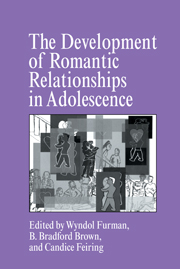Book contents
- Frontmatter
- Contents
- Contributors
- Foreword
- Acknowledgments
- 1 Missing the Love Boat: Why Researchers Have Shied Away from Adolescent Romance
- Part I Processes in Romantic Relationships
- Part II Individual Differences in Romantic Relationships
- Part III The Social Context of Romantic Relationships
- 10 Adolescent Romance and the Parent-Child Relationship: A Contextual Perspective
- 11 Romantic Relationships in Adolescence: The Role of Friends and Peers in Their Emergence and Development
- 12 “You're Going Out with Who?”: Peer Group Influences on Adolescent Romantic Relationships
- 13 The Cultured and Culturing Aspects of Romantic Experience in Adolescence
- 14 What's Love Got to Do with It? Adolescents' and Young Adults' Beliefs About Sexual and Romantic Relationships
- Part IV Conclusion
- Author Index
- Subject Index
11 - Romantic Relationships in Adolescence: The Role of Friends and Peers in Their Emergence and Development
Published online by Cambridge University Press: 05 October 2014
- Frontmatter
- Contents
- Contributors
- Foreword
- Acknowledgments
- 1 Missing the Love Boat: Why Researchers Have Shied Away from Adolescent Romance
- Part I Processes in Romantic Relationships
- Part II Individual Differences in Romantic Relationships
- Part III The Social Context of Romantic Relationships
- 10 Adolescent Romance and the Parent-Child Relationship: A Contextual Perspective
- 11 Romantic Relationships in Adolescence: The Role of Friends and Peers in Their Emergence and Development
- 12 “You're Going Out with Who?”: Peer Group Influences on Adolescent Romantic Relationships
- 13 The Cultured and Culturing Aspects of Romantic Experience in Adolescence
- 14 What's Love Got to Do with It? Adolescents' and Young Adults' Beliefs About Sexual and Romantic Relationships
- Part IV Conclusion
- Author Index
- Subject Index
Summary
The romantic preoccupations of adolescent youth – meeting potential partners, negotiating new situations, and learning the norms and nuances of love relationships – are central to the social activities of North American youth. In this new venture, adolescents find that it is their peers who are most willing to share in their desire to sort through the subtleties that characterize dating, love, and romance. Not only do friends act as a major conduit for romantic relationships, they typically are the romantic partners! In view of this overlap, the goal of this chapter is to explore the linkages between adolescents' romantic relationships and those with their peers. We focus particularly on development in early adolescence since the emergence of romantic relationships is characteristic of this time.
In adolescence, peer relationships undergo substantial differentiation, as the distinction between dyads and groups becomes increasingly important. Adolescents' peer relationships include small cliques of close friends and larger peer networks, as well as one-on-one friendships (Blyth, Hill, & Thiel, 1982). Whether peer relationships are dyadic or group-based likely shapes their links with romantic relationships, and we will attend to these differences in this chapter. We also recognize that children can be more or less successful in their peer relationships (Parker & Asher, 1987).
- Type
- Chapter
- Information
- The Development of Romantic Relationships in Adolescence , pp. 266 - 290Publisher: Cambridge University PressPrint publication year: 1999
- 187
- Cited by



